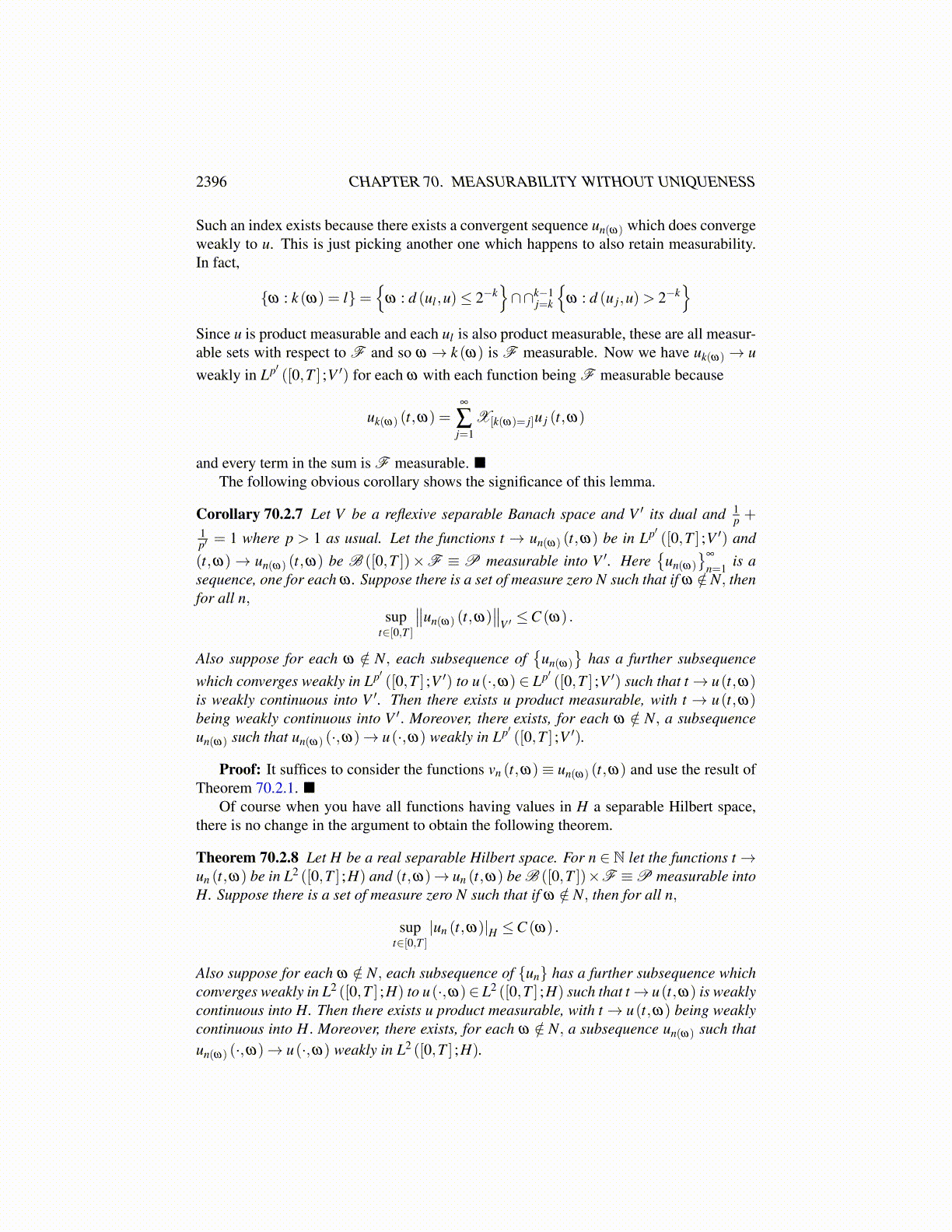
2396 CHAPTER 70. MEASURABILITY WITHOUT UNIQUENESS
Definition 70.2.4 Let Γ(ω)≡ ∩∞n=1Γn (ω).
Lemma 70.2.5 Γ is a nonempty F measurable set valued function having values in thecompact sub-sets of X. There exists a measurable selection γ . For γ a F measurableselection, (t,ω)→ γ (t,ω) is P measurable. Also, for each ω, there exists a subsequence,un(ω) (·,ω) such that for each k,
γk (t,ω) = limn(ω)→∞
f(un(ω) (t,ω)
)k = lim
n(ω)→∞
mk
∫ t
lmk (t)
⟨φ rk
,un(ω) (s,ω)⟩
V,V ′ds
Proof: Consider Γ(ω) =∩∞n=1Γn (ω) . Then ω→ Γ(ω) is a compact set valued map in
X . It is nonempty because each Γn (ω) is nonempty and compact, and these sets are nested.Is it F measurable? Each Γn is compact valued and F measurable. Hence if F is closed,
Γ(ω)∩F = ∩∞n=1Γ
n (ω)∩F
and the left is non empty if and only if each Γn (ω)∩F ̸= /0. Hence for F closed,
{ω : Γ(ω)∩F ̸= /0}= ∩n {ω : Γn (ω)∩F ̸= /0}
and soΓ− (F) = ∩nΓ
n− (F) ∈F
The last claim follows from the theory of multi-functions Theorem 70.1.2, [10], [70]. SinceΓn (ω) is compact, the measurability of Γn, that Γn− (U)∈F for U open implies the strongmeasurability of Γn, that Γn− (F) ∈F . Thus ω → Γ(ω) is non empty compact valued inX and F measurable.
From standard theory of measurable multi-functions, Theorem 70.1.2, [10], [70], thereexists a F measurable selection ω→ γ (ω) with γ (ω) ∈ Γ(ω) for each ω . Now it followsthat t → γk (t,ω) is continuous. This is what it means for γ (ω) ∈ X . What of the productmeasurability of γk? We know that ω → γk (ω) is F measurable into C ([0,T ]) and sosince pointwise evaluation is continuous, ω → γk (t,ω) is F measurable. Then since t →γk (t,ω) is continuous, it follows that γk is a P measurable real valued function and that γ
is a P measurable R∞ valued function.Since γ (ω) ∈ Γ(ω) , it follows that for each n,γ (ω) ∈ Γn (ω) . Therefore, there exists
jn ≥ n such that for each ω,
d (f(u jn (·,ω)) ,γ (ω))< 2−n
It follows that, taking a suitable subsequence, denoted as{
un(ω) (·,ω)}
,
γ (ω) = limn(ω)→∞
f(un(ω) (·,ω)
)for each ω . In particular, for each k
γk (t,ω) = limn(ω)→∞
f(un(ω) (t,ω)
)k = lim
n(ω)→∞
mk
∫ t
lmk (t)
⟨φ rk
,un(ω) (s,ω)⟩
V,V ′ds (70.2.2)